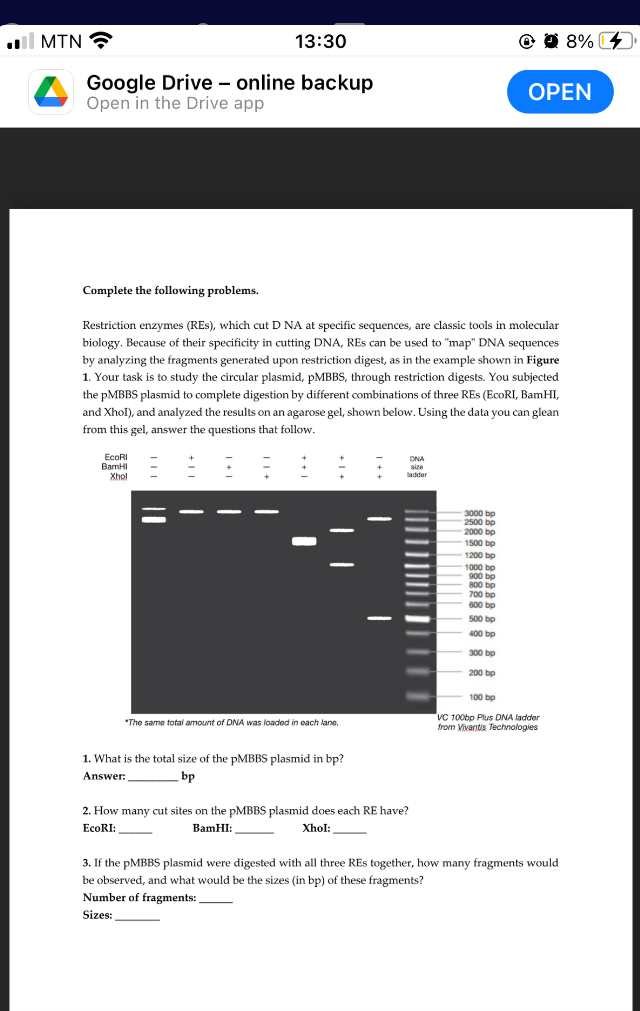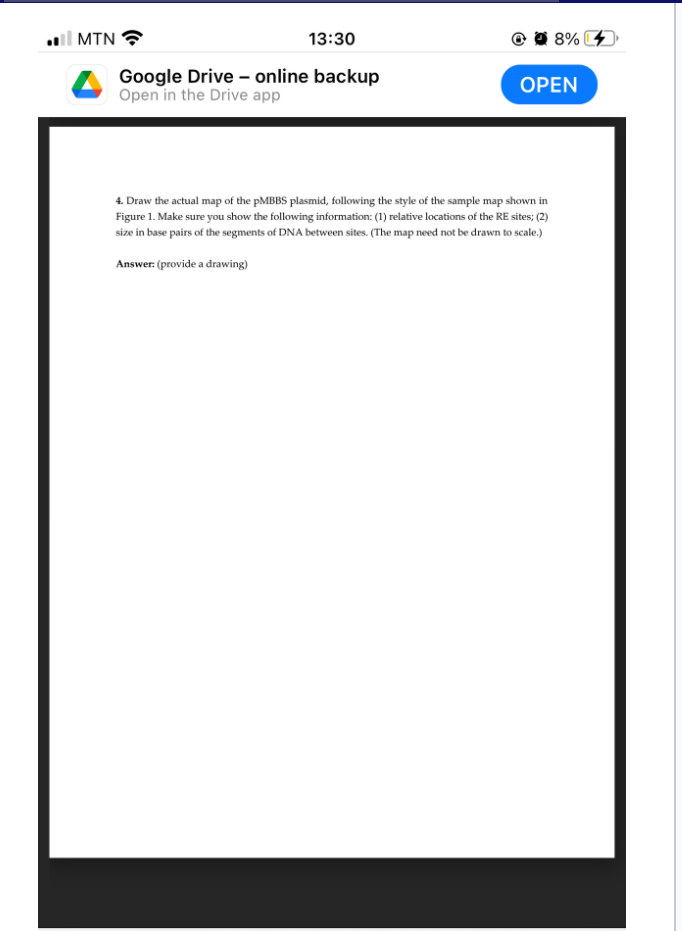Complete the following problems. Restriction enzymes (REs), which cut D NA at specific sequences, are classic tools in molecular biology. Because of their specificity in cutting DNA, REs can be used to "map" DNA sequences by analyzing the fragments generated upon restriction digest, as in the example shown in Figure 1. Your task is to study the circular plasmid, PMBBS, through restriction digests. You subjected the PMBBS plasmid to complete digestion by different combinations of three REs (ECORI, BamHI, and Xhol), and analyzed the results on an agarose gel, shown below. Using the data you can glean from this gel, answer the questions that follow. EcoRI BamHI Xhol DNA size ladder 3000 bp 2500 bp 2000 bp 1500 bp 1200 bp 1000 bp 900 bp 800 bp 700 bp 600 bp 500 bp 400 bp 300 bp 200 bp 100 bp "vC 100bp Plus DNA ladder from Vivantis Techvnologies "The same total amount of DNA was loaded in each lane. 1. What is the total size of the PMBBS plasmid in bp? Answer bp 2. How many cut sites on the pMBBS plasmid does each RE have? EcoRI:, BamHI:, Xhol: 3. If the pMBBS plasmid were digested with all three REs together, how many fragments would be observed, and what would be the sizes (in bp) of these fragments? Number of fragments: Sizes:
Complete the following problems. Restriction enzymes (REs), which cut D NA at specific sequences, are classic tools in molecular biology. Because of their specificity in cutting DNA, REs can be used to "map" DNA sequences by analyzing the fragments generated upon restriction digest, as in the example shown in Figure 1. Your task is to study the circular plasmid, PMBBS, through restriction digests. You subjected the PMBBS plasmid to complete digestion by different combinations of three REs (ECORI, BamHI, and Xhol), and analyzed the results on an agarose gel, shown below. Using the data you can glean from this gel, answer the questions that follow. EcoRI BamHI Xhol DNA size ladder 3000 bp 2500 bp 2000 bp 1500 bp 1200 bp 1000 bp 900 bp 800 bp 700 bp 600 bp 500 bp 400 bp 300 bp 200 bp 100 bp "vC 100bp Plus DNA ladder from Vivantis Techvnologies "The same total amount of DNA was loaded in each lane. 1. What is the total size of the PMBBS plasmid in bp? Answer bp 2. How many cut sites on the pMBBS plasmid does each RE have? EcoRI:, BamHI:, Xhol: 3. If the pMBBS plasmid were digested with all three REs together, how many fragments would be observed, and what would be the sizes (in bp) of these fragments? Number of fragments: Sizes:
Biochemistry
6th Edition
ISBN:9781305577206
Author:Reginald H. Garrett, Charles M. Grisham
Publisher:Reginald H. Garrett, Charles M. Grisham
Chapter28: Dna Metabolism: Replication, Recombination, And Repair
Section: Chapter Questions
Problem 1P: Semiconservative or Conservative DNA Replication If 15N-Iabeled E. coli DNA has a density of 1.724...
Related questions
Question
Hi please can I have the solution for the 4 question

Transcribed Image Text:l MTN ?
13:30
© 0 8% O
Google Drive - online backup
Open in the Drive app
ОPEN
Complete the following problems.
Restriction enzymes (RES), which cut D NA at specific sequences, are classic tools in molecular
biology. Because of their specificity in cutting DNA, REs can be used to "map" DNA sequences
by analyzing the fragments generated upon restriction digest, as in the example shown in Figure
1. Your task is to study the circular plasmid, pMBBS, through restriction digests. You subjected
the PMBBS plasmid to complete digestion by different combinations of three RES (ECORI, BamHI,
and Xhol), and analyzed the results on an agarose gel, shown below. Using the data you can glean
from this gel, answer the questions that follow.
EcoRI
BamHI
Xhol
DNA
size
ladder
3000 bp
2500 bp
2000 bp
1500 bp
1200 bp
1000 bp
900 bp
800 bo
700 bp
600 bp
500 bp
400 bp
300 bp
- 200 bp
100 bo
vC 100bp Plus DNA ladder
from Vivantis Technologies
"The same total amount of DNA was loaded in each lane.
1. What is the total size of the PMBBS plasmid in bp?
Answer:
bp
2. How many cut sites on the PMBBS plasmid does each RE have?
BamHI:
EcoRI:
Xhol:
3. If the pMBBS plasmid were digested with all three REs together, how many fragments would
be observed, and what would be the sizes (in bp) of these fragments?
Number of fragments:
Sizes:

Transcribed Image Text:l MTN
13:30
O 8%
Google Drive - online backup
Open in the Drive app
OPEN
4. Draw the actual map of the PMBBS plasmid, following the style of the sample map shown in
Figure 1. Make sure you show the following information: (1) relative locations of the RE sites; (2)
size in base pairs of the segments of DNA between sites. (The map need not be drawn to scale.)
Answer: (provide a drawing)
Expert Solution
This question has been solved!
Explore an expertly crafted, step-by-step solution for a thorough understanding of key concepts.
This is a popular solution!
Trending now
This is a popular solution!
Step by step
Solved in 2 steps

Knowledge Booster
Learn more about
Need a deep-dive on the concept behind this application? Look no further. Learn more about this topic, biology and related others by exploring similar questions and additional content below.Recommended textbooks for you

Biochemistry
Biochemistry
ISBN:
9781305577206
Author:
Reginald H. Garrett, Charles M. Grisham
Publisher:
Cengage Learning

Biology: The Dynamic Science (MindTap Course List)
Biology
ISBN:
9781305389892
Author:
Peter J. Russell, Paul E. Hertz, Beverly McMillan
Publisher:
Cengage Learning

Biology: The Unity and Diversity of Life (MindTap…
Biology
ISBN:
9781305073951
Author:
Cecie Starr, Ralph Taggart, Christine Evers, Lisa Starr
Publisher:
Cengage Learning

Biochemistry
Biochemistry
ISBN:
9781305577206
Author:
Reginald H. Garrett, Charles M. Grisham
Publisher:
Cengage Learning

Biology: The Dynamic Science (MindTap Course List)
Biology
ISBN:
9781305389892
Author:
Peter J. Russell, Paul E. Hertz, Beverly McMillan
Publisher:
Cengage Learning

Biology: The Unity and Diversity of Life (MindTap…
Biology
ISBN:
9781305073951
Author:
Cecie Starr, Ralph Taggart, Christine Evers, Lisa Starr
Publisher:
Cengage Learning

Biology 2e
Biology
ISBN:
9781947172517
Author:
Matthew Douglas, Jung Choi, Mary Ann Clark
Publisher:
OpenStax